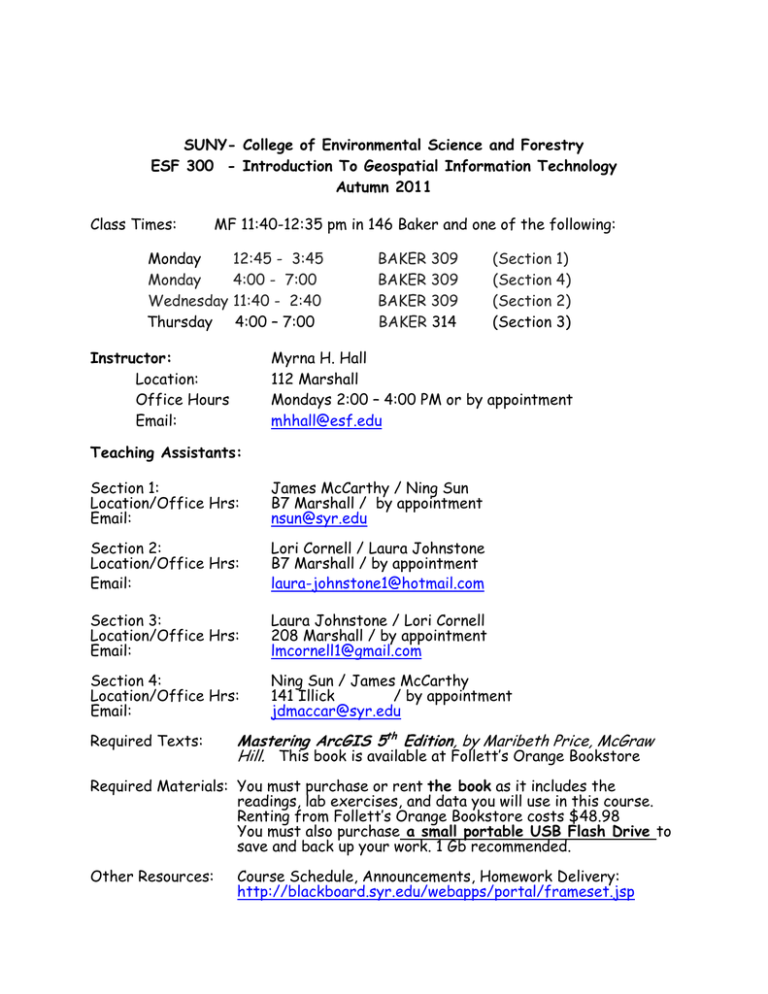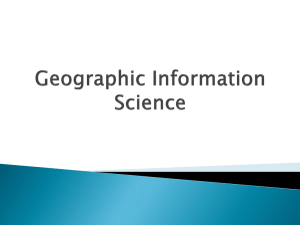SUNY- College of Environmental Science and Forestry
advertisement

SUNY- College of Environmental Science and Forestry ESF 300 - Introduction To Geospatial Information Technology Autumn 2011 Class Times: MF 11:40-12:35 pm in 146 Baker and one of the following: 12:45 - 3:45 Monday Monday 4:00 - 7:00 Wednesday 11:40 - 2:40 Thursday 4:00 – 7:00 BAKER 309 BAKER 309 BAKER 309 BAKER 314 (Section 1) (Section 4) (Section 2) (Section 3) Myrna H. Hall 112 Marshall Mondays 2:00 – 4:00 PM or by appointment mhhall@esf.edu Instructor: Location: Office Hours Email: Teaching Assistants: Section 1: Location/Office Hrs: Email: James McCarthy / Ning Sun B7 Marshall / by appointment nsun@syr.edu Section 2: Location/Office Hrs: Email: Lori Cornell / Laura Johnstone B7 Marshall / by appointment laura-johnstone1@hotmail.com Section 3: Location/Office Hrs: Email: Laura Johnstone / Lori Cornell 208 Marshall / by appointment lmcornell1@gmail.com Section 4: Location/Office Hrs: Email: Ning Sun / James McCarthy 141 Illick / by appointment jdmaccar@syr.edu Required Texts: Mastering ArcGIS 5th Edition, by Maribeth Price, McGraw Hill. This book is available at Follett’s Orange Bookstore Required Materials: You must purchase or rent the book as it includes the readings, lab exercises, and data you will use in this course. Renting from Follett’s Orange Bookstore costs $48.98 You must also purchase a small portable USB Flash Drive to save and back up your work. 1 Gb recommended. Other Resources: Course Schedule, Announcements, Homework Delivery: http://blackboard.syr.edu/webapps/portal/frameset.jsp Student Responsibilities: As a student in Introduction to GIT it is your responsibility to attend the lectures and labs, do the readings and lab exercises. All material from lectures and readings may appear on the examinations. If you need any assistive devices, services, or accommodations, due to a disability, please contact the Instructor. Course Description: ESF 300 is an introduction to geographical information technology, focusing on spatial data acquisition, development and analysis in the science and management of natural resources. Topics covered include basic data structures, data sources, data collection, data quality, geodesy and map projections, spatial and tabular data analyses, digital elevation data and terrain analyses, cartographic modeling, and cartographic layout. Laboratory exercises provide practical experiences that complement the theory covered in lecture. Course Goals: The overall goal of the course is to provide students with the theoretical and practical knowledge necessary to understand the uses and limitations of Geographic Information Technology (GIT) for a variety of natural resource and ecological applications in both natural and human-dominated environments. Objectives: 1. increase student awareness of GIS science and technology in environmental management; 2. introduce fundamental tools used for mapping natural resources; 3. provide experience in mapping land cover conditions using maps, aerial photographs, satellite images, and navigation-grade GPS technology; 4. provide experience in digital spatial analysis techniques; and 5. generate enthusiasm and interest in using GIS for meeting environmental management needs Student Outcomes: At the end of the course, the student should be able to: 1. Define, compare and contrast different types of maps and explain fundamental cartographic principles 2. Compare and contrast different map projections and coordinate systems used for georeferencing locations on the earth’s surface 3. Compare and contrast the major characteristics of various sources of remote sensing data available for environmental applications, including satellite imagery, and explain the advantages and disadvantages of each 4. Define, compare and contrast raster and vector data structures used in GIS software 5. Acquire and input georeferenced data from a variety of sources, including maps, digital imagery and navigation-grade GPS, for use in a GIS 6. Define and explain the sources of error in digital data 7. Efficiently manage and query both spatial and attribute data within a GIS 8. Conduct appropriate spatial analyses, using both raster and vector data sources, within a GIS to answer specific environmental management and ecological and sociological research questions 9. Produce quality maps which summarize output from simple spatial analysis using appropriate cartographic principles 10. Demonstrate professionalism Course Grading 1. ATTENDANCE: Class attendance is vital -- absences, for any reason, do not relieve the student of the responsibility for laboratories, quizzes and lecture materials covered during the absence. 2. LABORATORY REPORTS: Laboratory reports are due at the end of the lab (eol), or day of lab plus 3 days later (dol + 3) if indicated. Check the class schedule below. Late laboratory reports will be severely penalized: − 50% grade reduction if turned in 1 to 3 class days late; − 100% grade reduction if turned in over 3 class days late! 3. EXAMS: Exams will be comprehensive and will cover all materials presented in lectures, laboratories, and reading assignments 4. GRADE WEIGHTING: 12 Lab Reports Final Project 5 Quizzes & Final Exam TOTAL 55% 15% 15% 15% 100% 5. GRADE SCALE Grade Min % A 93 A90 B+ 87 B 83 B80 C+ 77 C 73 C70 D 60 F <60 Lab Policies: The first 20 minutes will be used to provide specific connections between theory covered in the lecture with implementation of GIS technologies, and going through lab mechanics. The lab instructors will remain in the lab for the duration of the lab period to answer questions and offer help. Each lab will introduce new concepts and commands. Watch the skill set demonstration video provided on the CD in your book prior to attending lab, and review/note new procedures or activities. Note some students may require more than the allotted three-hour period to complete the lab. If this occurs you will need to work on your own. The computer facility in Baker and the basement of Moon Library are open additional hours for you to complete your labs. If you read the lab handouts in advance of the lab, you are more likely to complete the work by the end of the lab period and get your questions answered by the instructor during the lab period. Registered students will also receive a 1 year evaluation copy of ArcGIS 10.0, which can be installed on a home computer. To complete Labs at home, the data files for the class must be copied/transferred from the lab computers to a memory stick or portable hard drive. The data files for this class are very large (over 2GB). Do not email the instructor or the TA for help. The best way to obtain support for completing the lab is to attend your assigned lab session. If you miss your section and wish to attend another section you may do so only by prior request to the TA in charge. You may not occupy a computer needed by students of that section. You may work on your own computer but help will be given to students enrolled in that section first. If you know you will be having a conflict for a significant event or emergency (wedding, childbirth, funeral, surgery) contact the instructor and your TA. Please note you may work together on labs, but you each must do every part of each lab, and turn in entirely your own work. That means each of you should perform every step indicated in the lab manual at your own computer. Your grade is for individual effort; copied files/maps from other students will be construed as cheating. At a minimum you’ll get a zero for the lab, and you may automatically fail the course and be reported to the Dean of Student Life for disciplinary action. Schedule for ESF 300, Introduction to Geographic Information Technology (subject to change as needed) Shaded dates signify quiz and test dates. Week Dates Topic Reading* Lab* Due 1 8/29 – 9/02 2 9/05 - 9/09 3 9/12 – 9/16 4 5 6 7 8 9 10 11 12 13 9/19 – 9/23 9/26 – 9/30 10/03 - 10/07 10/10 – 10/14 10/17 – 10/21 10/24 – 10/28 10/31 – 11/04 11/07 – 11/11 11/14 – 11/18 11/21 – 11/25 14 15 11/28 – 12/02 12/05 – 12/09 GIS/GIT (M) pp. 1 - 6 Coordinate Systems (F) No Class (M) Coordinate Systems (F) pp. 295 - 310 GPS Technology (M) On BB Guest Lecturer - Jackie Frair (F) Remote Sensing (M/F) On BB GIS Data (M/F) pp. 9 - 24 GIS Data (M/F) Mapping GIS data (M) pp. 41 - 53 Attribute Data (M) pp. 99 -113 Queries (M) pp. 129 – 141 Spatial Joins (M/F) pp. 155 - 169 Geoprocessing (M) pp. 185 - 197 Raster Analysis (M/F) pp. 215 - 228 Final (M) THANKSGIVING (F) Cartographic Modeling (M) On BB Metadata (M) Map Basics eol pp. 311-326 (W,Th) Handout eol eol Handout Data Models pp. 25 - 40 pp. 54 -70 pp. 114 -128 pp. 142 - 154 pp. 170 - 184 pp. 198 - 214 pp. 229 - 244 pp. 311-326 (M, only) eol eol dol+3 dol+3 dol+3 dol+3 dol+3 dol+3 dol+3 dol Handout Day of Finals ** Work on Final Project * found in Mastering ArcGIS 5th Edition by Maribeth Price, McGraw Hill, Dubuque, IA ** Date and Time __________________ eol = end of lab dol+ = day of lab plus some number of days BB = Blackboard





